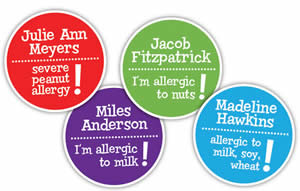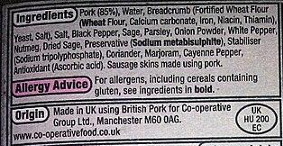41 hidden allergens are always listed on labels
Food Allergy & Anaphylaxis | Food Labeling | Food Labels Carefully check items that are labeled "nut." The U.S. Food and Drug Administration (FDA) classifies several items as "tree nuts" that are fruits, not tree nuts. These include coconut, lichee nut, shea nut, and Ginko nut. If you have tree nut allergies, talk with your board-certified allergist about whether to avoid these foods. Hidden Food Allergens: Are Food Labels Reliable? - WebMD The Food Allergen Labeling and Consumer Protection Act requires food manufacturers to clearly indicate when they've used one of eight major allergens: milk, eggs, fish, shellfish, peanuts, tree...
Food Labelling | Allergy UK | National Charity This legislation has been in place since December, 2014 and mandates that ingredient lists on food labels have to clearly highlight (for example in bold type) that they contain any of the 14 allergens which include: Celery Cereals including gluten Crustaceans Eggs Fish Lupin Milk (Cows) Molluscs Mustard Nuts Peanuts Sesame seeds Soya
Hidden allergens are always listed on labels
Hidden Dairy: Foods, Medication, and Beyond - Go Dairy Free By Alisa Fleming on May 16, 2006 Food Label Info There are the obvious dairy foods such as cow's milk (chocolate, whole, skim, malted, evaporated, etc.), buttermilk, half and half, cream, butter, cheese, ice cream, milk shakes, and yogurt. However, did you know that the majority of processed foods also contain dairy? Avoiding Hidden Allergens | Always Food Safe - Food Manager ... The most important thing to do when trying to avoid an allergen is to check the label carefully. The USDA requires that the 8 major food allergens be listed in plain English on the label. Labels will also mention if there could be traces of a certain allergen or if it was produced at the same facility as one. Did You Know Egg is in this Product? - SoCal Food Allergy Institute - A ... Here is a list of products that contain eggs and where they are hidden. Egg allergy is serious. From a local reaction to anaphylaxis, an egg allergy means you need to know how to identify egg proteins a slew of products. Whether egg protein is in your food to the lotion you use, reading all of your products' labels is important for staying safe.
Hidden allergens are always listed on labels. Cleaning Supplies: Secret Ingredients, Hidden Hazards EWG research into more than 2,000 common cleaning products lays bare the troubling consequences of the lack of federal oversight over the ingredients in cleaning supplies. Manufacturers can use nearly any substance they want, even those known to pose health or environmental hazards. And they can hide information about virtually all those ... 38 Foods Where Gluten May Be "Hidden" - GIG® Gluten Intolerance ... However, there are no required warnings for barley or rye, because those grains are not considered major allergens by the FDA. The Food Allergen Labeling and Consumer Protection Act of 2004 (FALCPA) identified eight foods as major food allergens: milk, eggs, fish, shellfish, tree nuts, peanuts, wheat, and soybean. How to Read an Ingredients Label for Food Allergies - Verywell Health The Food Allergy Labeling and Consumer Protection Act (FALCPA) The Food Allergy Labeling and Consumer Protection Act (FALCPA) became effective in 2006 and requires the top 8 food allergens ( milk, soy, egg, wheat, peanut, tree nut, fish, and shellfish) be highlighted separately on the ingredients label in plain, easy-to-understand language. The Big 8 Food Allergens - The Food Institute More than 170 foods have been reported to cause allergic reactions, but eight major food allergens, also known as the Big 8, are responsible for most of the serious food allergy reactions in the U.S., according to Food Allergy Research & Education. The Big 8 list is comprised of milk, eggs, fish, crustacean shellfish, tree nuts, peanuts, wheat ...
Tips for Avoiding Hidden Food Allergens | MyFoodAllergyTeam "The labels list it as spices or seasonings." Spices or seasonings could also include garlic or herbs. Natural flavors/flavoring: "I avoid anything that says 'natural flavors' because you never know what's in them," a member wrote. While paying strict attention to food labels is time-consuming, some members see a silver lining. How to Make Sense of Allergy Warning Labels on Foods This is done in one of two ways: 1. The name of the food source appearing in parentheses following the name of the ingredient. Example: "flour (wheat)" or "whey (milk)". 2. Immediately after or next to the list of ingredients in a "contains" statement. For example, contains "milk, wheat, and soy" — more on this below. How to Read a Food Label - FoodAllergy.org While all ingredients in a food are supposed to be listed in the ingredients list, FALCPA covers only the eight most common allergens. These are milk, egg, peanut, tree nuts, soy, wheat, fish and crustacean shellfish. Note that molluscan shellfish—such as oysters, clams, mussels or scallops—are not required to be labeled as a major allergen. Pandemic-Inspired Food Labeling Raises Alarms for Those With Food Allergies The top eight recognized food allergens in the U.S. — milk, eggs, fish, shellfish, peanuts, tree nuts, wheat and soy — as well as other priority allergens, including sesame, celery, lupin (a...
Understanding Sesame Allergies: Symptoms, Treatment, and More - Healthline Sesame is a common hidden allergen, however. It's not always listed on the food labels of products that contain it. Avoid foods that have product labels that are unclear or don't specify... Food Allergies | FDA To protect those with food allergies and other food hypersensitivities, the FDA enforces regulations requiring companies to list ingredients on packaged foods and beverages. For certain foods or... Spices and Food Allergy - Kids With Food Allergies Sesame allergy is one of the most common food allergies in the United States. Sesame is a seed, but it is common in spice blends. A sesame allergy can cause anaphylaxis. If you have a sesame allergy, read labels carefully on spice blends. Until 2023, sesame does not need to be clearly labeled on packaged foods in the United States. Don't Be Fooled by Food Labels - WebMD If it's labeled "natural," it's healthier. a. True. b. False. Sources | Medically Reviewed on August 02, 2021. This tool does not provide medical advice. See additional information.
How to Identify Gluten on Food Labels - Verywell Health The following terms represent ingredients that always contain gluten: Wheat protein/hydrolyzed wheat protein Wheat starch/hydrolyzed wheat starch Wheat flour/bread flour/bleached flour Bulgur: A form of wheat Malt: Made from barley Couscous : Made from wheat Farina: Made from wheat Pasta: Made from wheat unless otherwise indicated
PDF The Food Allergen Labeling and Consumer Protection Act Sufferers Always Face Danger of Hidden, Related Ingredients, THE PLAIN DEALER, OCT. 16, 1996, at 1E (a child's allergic reaction to walnut allergens, resulting from a mother's touch on the face with her "clean" hands that had earlier touched walnuts). 11 The terms allergy and hypersensitivity are often used interchangeably in product
Which Allergens Are in Your Food? You Can't Always Tell From the Labels ... It's easy to tell when certain allergens are present Congress passed the Food Allergen Labeling and Consumer Protection Act in 2004, a rule book for manufacturers. Companies must tell consumers if...
If My Child Has Food Allergies, What Should I Look for ... - KidsHealth In the United States, companies must state, in understandable language, if a product contains one of the 8 most common food allergens: peanuts, tree nuts, eggs, milk, wheat, soy, fish, and crustacean shellfish. Know the limits of food labels. Not all allergens will be included in ingredient lists or named in a recognizable way.
Hidden Gluten, Grains and Nightshades in Meds and Supplements Below are some guidelines for assuring your meds and supplements remain free of gluten, grains, and nightshades: 1. Read all ingredient labels, even on a new bottle of the same old product. Become familiar with the names of fillers sourced from ingredients you need to avoid, or carry a list of suspect fillers when you shop (this also applies to ...
Understanding Food Labels - Go Dairy Free This handy quick guide includes the essentials to understanding food labels for dairy-free diets. Click on any of the links or images below to get information on understanding food allergen labeling (including how to spot milk when it isn't clearly noted), foods and all types of other products where dairy may hide (yes, even in paint and ...
Food labels may not tell you everything: Healthy Living The eight most common food allergens -- milk, eggs, peanuts, tree nuts, shellfish, fish, soy and wheat -- must be listed. If there's any hint of these items in foods, you will see phrases like "may...
Common Food Allergies: What are the Big 8 Allergens? There are 8 allergens in particular that are thought to be responsible for 90% of allergic reactions. These are known as 'the big 8 allergens': Milk. Eggs. Fish. Crustacean shellfish. Tree nuts. Peanuts. Wheat. Soybeans. Living with a food allergy or food intolerance can be challenging; you need to be very careful about what you eat.
PDF Allergen Labeling on Food Products - University of Minnesota Note that major food allergens (as discussed on pages 20-24 of the FDA Labeling Guide), even if they are present only in trace amounts, must be declared. They include: 1. Milk 2. Eggs 3. Fish The specific species of fish must be declared (e.g., bass, cod, flounder). See Guidance for Industry: The Seafood List. 4.
Tracking Down Hidden Food Allergies | AskDrSears The most common alternative foods that can cause hidden food allergies include: dairy products: Casein, sodium caseinate. Careful label reading will help you discover what you are eating: Cocoa mixes, creamed foods, gravies, and some sauces contain milk. Noodles and pasta contain wheat and sometimes eggs. Canned soups may contain wheat and ...









Post a Comment for "41 hidden allergens are always listed on labels"